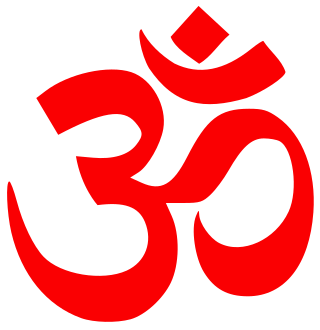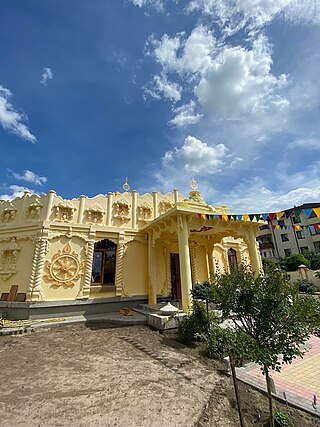
Sathya Sai Baba was an Indian guru and philanthropist. At the age of 14, he said he was the reincarnation of Shirdi Sai Baba and left his home saying "my devotees are calling me, I have my work."

The International Society for Krishna Consciousness (ISKCON), known colloquially as the Hare Krishna movement, is a Gaudiya Vaishnava Hindu religious organization. It was founded on 13 July 1966 in New York City by A. C. Bhaktivedanta Swami Prabhupada. Its main headquarters is located in Mayapur, West Bengal, India.

Hinduism has been spread in Russia primarily due to the work of scholars from the religious organization International Society for Krishna Consciousness (ISKCON) and by itinerant Swamis from India and small communities of Indian immigrants. While ISKCON appears to have a relatively strong following in Russia, the other organizations in the list have a marginal presence in this country. There is an active Tantra Sangha operating in Russia. According to the 2012 official census, there are 140,010 Hindus in Russia, which accounts for 0.1% of the population of Russia.

Hinduism is a minor religious faith in Finland.

Hinduism is a minority religion constituting about 0.15% of the population of Austria. Hinduism is not one of the 16 recognised religions in Austria. The Austrian law allows religious groups not recognized as societies to seek official status as confessional communities with the Office for Religious Affairs. Hinduism is one of the eight confessional communities in Austria. However, the Sahaja Yoga and the International Society for Krishna Consciousness are categorised as associations, not as confessional communities.

The Radha-Krishna Temple is the headquarters of the International Society for Krishna Consciousness (ISKCON) in the United Kingdom since the late 1960s. It was founded in Bury Place, Bloomsbury, by six devotees from San Francisco's Radha-Krishna Temple, who were sent by ISKCON leader A.C. Bhaktivedanta Swami Prabhupada to establish a UK branch of the movement in 1968. The Temple came to prominence through George Harrison of the Beatles publicly aligning himself with Krishna consciousness. Among the six initial representatives in London, devotees Mukunda, Shyamsundar and Malati all went on to hold senior positions in the rapidly growing ISKCON organisation.

Hinduism in Mongolia is a minority religion; it has few followers and only began to appear in Mongolia in the late twentieth century. According to the 2010 and 2011 Mongolian census, the majority of people that identify as religious follow Buddhism (86%), Shamanism (4.7), Islam (4.9%) or Christianity (3.5). Only 0.5% of the population follow other religions.

Hinduism is a minority religion in Ukraine. It is followed by 0.1% of the population, with a slightly higher proportion in Western Ukraine (0.2%).

There is relatively little history of active practice of Hinduism in Romania, although many prominent Romanian thinkers have had an interest in Hindu thought, and since the Romanian Revolution of 1989 there have been some converts through the work of International Society for Krishna Consciousness. Hare Krishna devotee provide free food for life program and other cultural festivals around the country. Every year Hare Krishna devotee organise Rath Yatra of Lord Jagganath and thousands of people participate in the Rath Yatra.

Hinduism is a minority religion in Belgium. According to the PEW 2014, Hinduism is also the fastest growing religion in Belgium. Attempts have been done by the Hindu Forum of Belgium (HFB) to make Hinduism an officially-recognized religion in Belgium.
The Sathya Sai Baba movement is a new religious movement inspired by South Indian Neo-Hindu guru Sathya Sai Baba who taught the unity of all religions. Some of his followers have faith in his claim to be a purna Avatar of Shiva and Shakti, who is believed to have been predicted in the Bhagavad Gita. This means that some of his followers see him as a God. Devotees engage in singing devotional songs called "bhajans" and selfless service (seva). Its official organization is the Sathya Sai Organization. However the Sathya Sai Baba movement extends beyond the organization. An important aspect of the faith of adherents is the miracles attributed to Sathya Sai Baba. The number of adherents is estimated between 6 and 100 million.

Hinduism was first introduced by Sindhi settlers who migrated to Ghana after India was divided in 1947. It was spread to Ghana actively by Ghana's Hindu Monastery headed by Swami Ghananand Saraswati and by the International Society for Krishna Consciousness (ISKCON). Hinduism is one of the fastest growing religions in Ghana.

Hinduism is a minority religion in Slovenia. ISKCON was registered in Slovenia in 1983 and The Hindu Religious Community in Slovenia was registered in 2003 in Ljubljana

Hinduism is a minority religion in Hungary. According to the 2022 census, there were 3,307 Hindus in Hungary.

Hinduism in Poland is a minority religion. Hinduism has spread to Poland through ISKCON since 1976. First groups of Polish devotees were established in Warsaw and Wrocław. The first Polish Hindu temple was established in 1980 in Czarnów, Lower Silesian Voivodeship. Main ISKCON temple is New Ramana Reti Temple in Mysiadło.

Hinduism in Israel refers to the Hindu population in Israel. In 2020, about 0.01% of Israel's population were Hindus.

Hinduism is a minority religion and a fairly recent development in Lithuania. Hinduism is spread in Lithuania by Hindu organizations: ISKCON, Sathya Sai Baba, Brahma Kumaris and Osho Rajneesh. As of 2015, there were 580 (0.02%) Hindus in Lithuania.

Hinduism in Greece has a small following. On March 1, 2006, the Greek government passed a law allowing cremation. This law was welcomed by the Indian community in Athens. In 2012, there were about 20,000 Hindus in Greece.

Hinduism spread to Nigeria mainly by arrival of Hindus from India and by way of ISKCON. Sindhis were the first to arrive in Nigeria in the early part of the nineteenth century. Initially, they were primarily engaged in trading but gradually, while retaining their interest in trading, they ventured into other fields such as manufacturing and professional services. In succeeding decades, they made substantial investments, aggregating more than US$4 billion. Sindhi names like Chellaram, Bhojson, Chandrai etc are well known in Nigeria. Indian Sindhis run Superstores and are in the textiles sector, as well as in pharmaceuticals, fishing and engineering industries. Around 1 million Indians live in Nigeria.
The reception of Hinduism in the Western world began in the 19th century, at first at an academic level of religious studies and antiquarian interest in Sanskrit.









